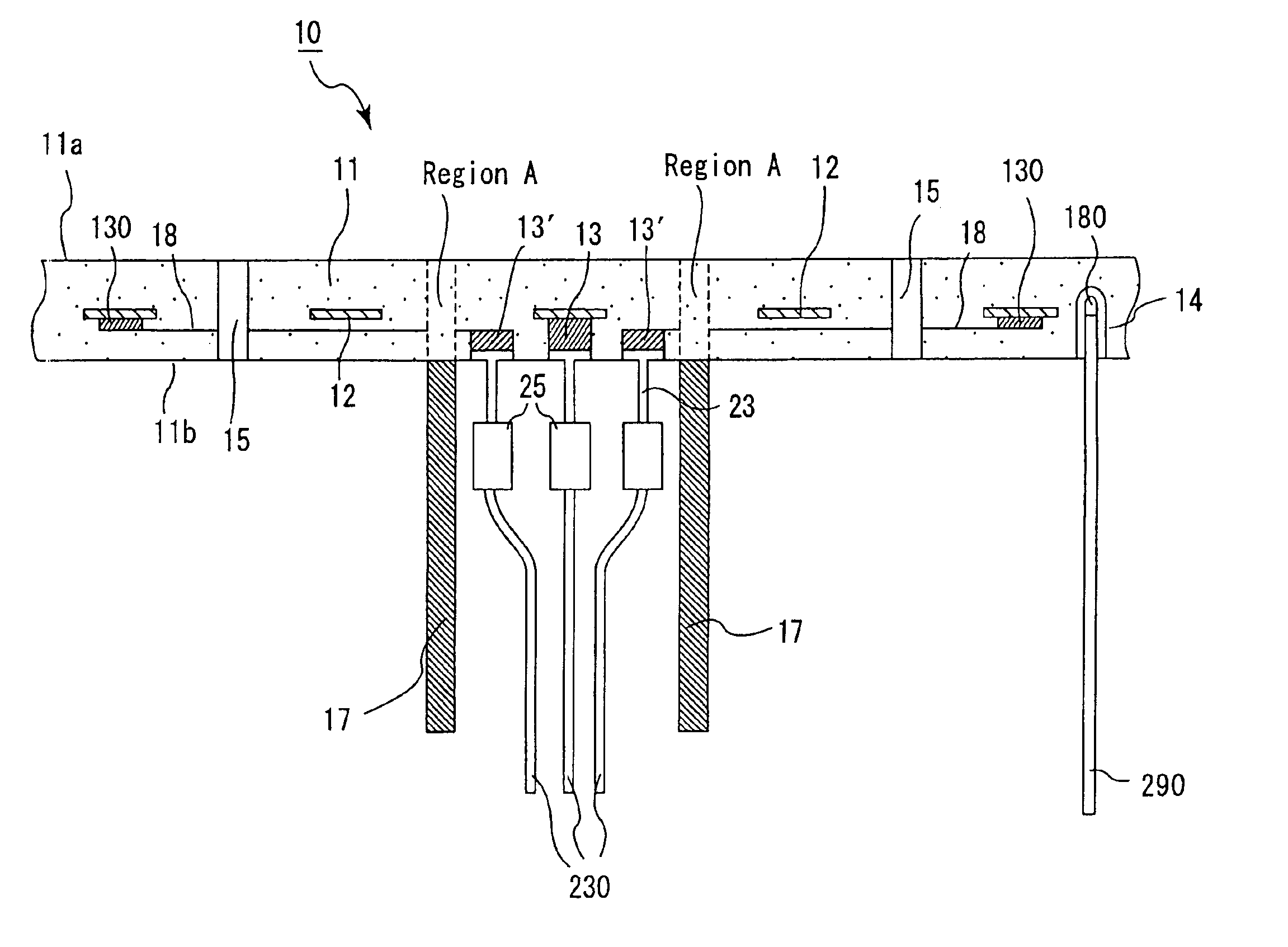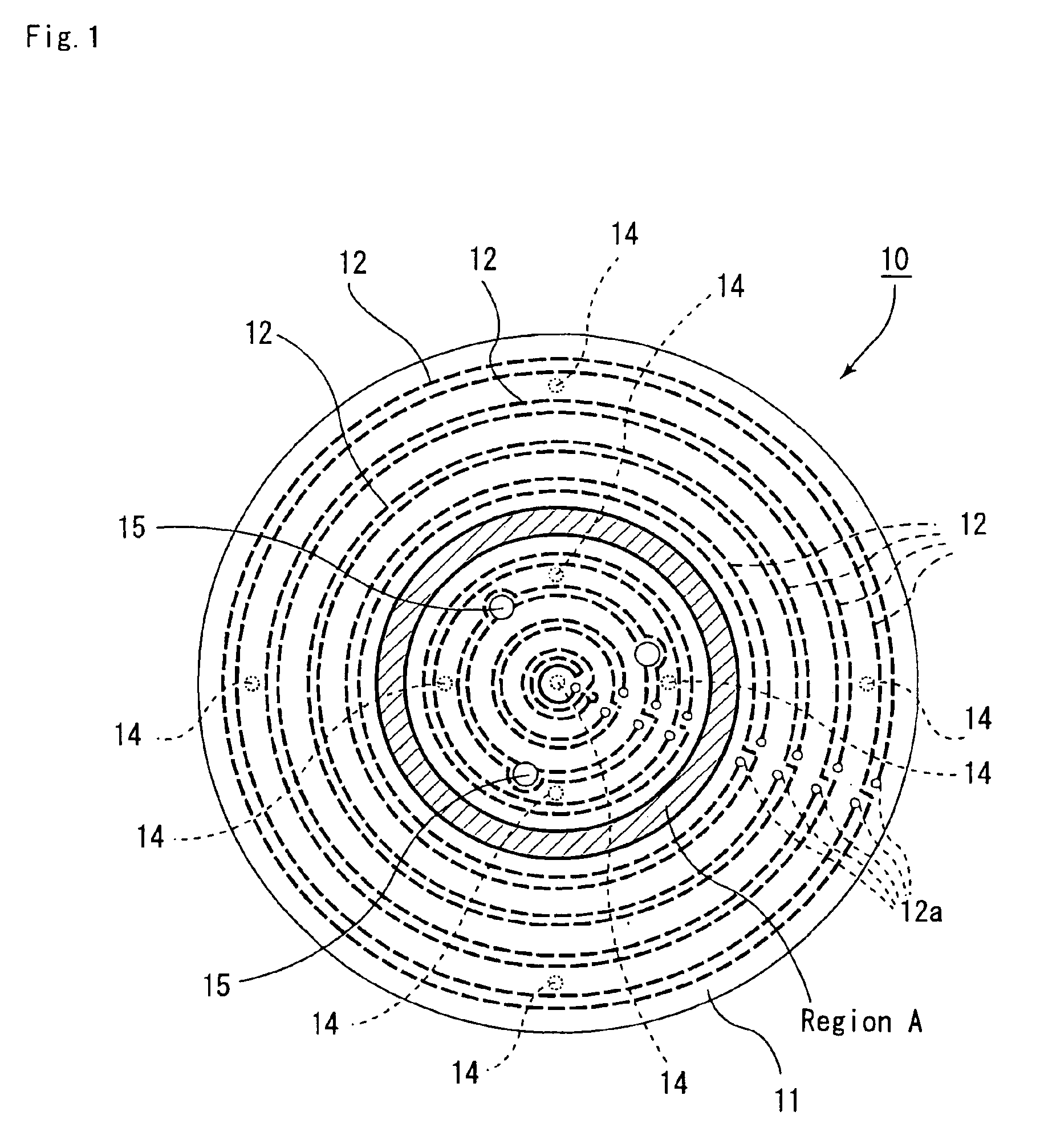Ceramic joint body
a joint body and ceramic technology, applied in the field of ceramic bonded bodies, can solve the problems of insufficient corrosion resistance of the bonded part, inability to stand for use, corroded ceramic, etc., and achieve the effects of preventing warping, preventing damage of objects, and suppressing warping
- Summary
- Abstract
- Description
- Claims
- Application Information
AI Technical Summary
Benefits of technology
Problems solved by technology
Method used
Image
Examples
example 1
Production of an Electrostatic Chuck (see FIGS. 4 to 6)
[0159](1) Green sheets with a thickness of 0.47 mm were obtained by forming a composition obtained by mixing 100 parts by weight of an aluminum nitride powder (produced by Tokuyama Corporation, average particle size of 1.1 μm), 4 parts by weight of Y2O3 (average particle size of 0.4 μm), 12 parts by weight of an acrylic resin-based binder, 0.5 parts by weight of a dispersant, and 53 parts by weight of alcohol consisting of 1-butanol and ethanol by a doctor blade method.
[0160](2) Next, after the green sheets were dried at 80° C. for 5 hours, the following green sheets were formed: green sheets which were not processed, the green sheets having through holes for via holes for connecting resistance heating elements and conductor circuits by punching, the green sheets having through holes for via holes for connecting conductor circuits and external terminals, and the green sheets having through holes for via holes for connecting elec...
example 2
Production of a Ceramic Heater (see FIGS. 1 to 3 and FIG. 9)
[0175](1) Green sheets with a thickness of 0.47 mm were obtained by forming a composition obtained by mixing 100 parts by weight of an aluminum nitride powder (produced by Tokuyama Corporation, average particle size of 1.1 μm), 4 parts by weight of yttrium oxide (Y2O3:yttria average particle size of 0.4 μm), 11.5 parts by weight of an acrylic resin-based binder, 0.5 parts by weight of a dispersant, and 53 parts by weight of alcohol consisting of 1-butanol and ethanol by a doctor blade method.
[0176](2) Next, after the green sheets were dried at 80° C. for 5 hours, portions 15 to be through holes for letting lifter pins pass through to transport a silicon wafer, portions to be via holes 630, and portions to be conductor-filled through holes 63, 63′ were formed by punching as shown FIG. 1.
[0177](3) A conductor containing paste A was produced by mixing 100 parts by weight of a tungsten carbide particle having an average particl...
example 3
[0191]In this example, as shown in FIG. 10, a ceramic bonded body 42 was produced in the same manner as Example 1, except that patterns were formed so as to make resistance heating elements 42 exist in a large portion of the region (region A) above the bonding interface of the cylindrical body 17 and the ceramic substrate 41 (80% of the area of the bonding interface in a plan view, accordingly, the region where no resistance heating element existed was 20%). Incidentally, the resistance heating elements 42 were bonded with external terminals 23 via through holes 43 by a Ag / Ni brazing material (not illustrated).
PUM
| Property | Measurement | Unit |
|---|---|---|
| Fraction | aaaaa | aaaaa |
| Percent by mass | aaaaa | aaaaa |
| Weight | aaaaa | aaaaa |
Abstract
Description
Claims
Application Information
 Login to View More
Login to View More - R&D
- Intellectual Property
- Life Sciences
- Materials
- Tech Scout
- Unparalleled Data Quality
- Higher Quality Content
- 60% Fewer Hallucinations
Browse by: Latest US Patents, China's latest patents, Technical Efficacy Thesaurus, Application Domain, Technology Topic, Popular Technical Reports.
© 2025 PatSnap. All rights reserved.Legal|Privacy policy|Modern Slavery Act Transparency Statement|Sitemap|About US| Contact US: help@patsnap.com



